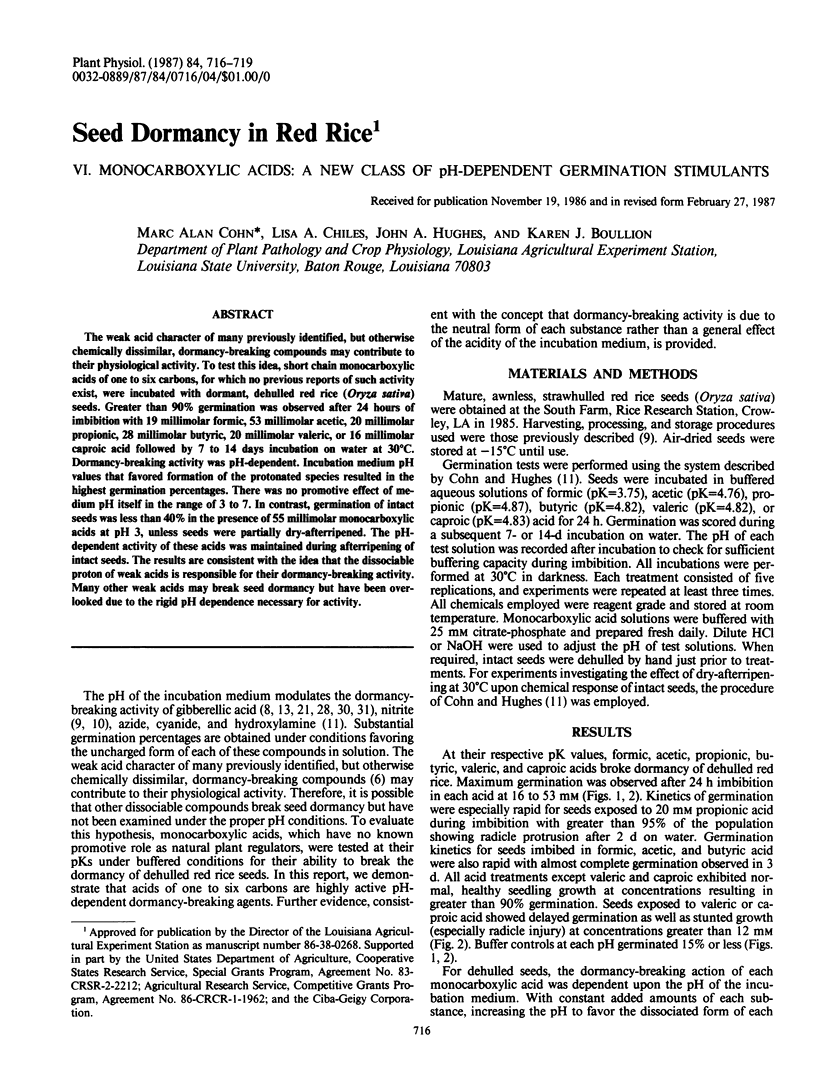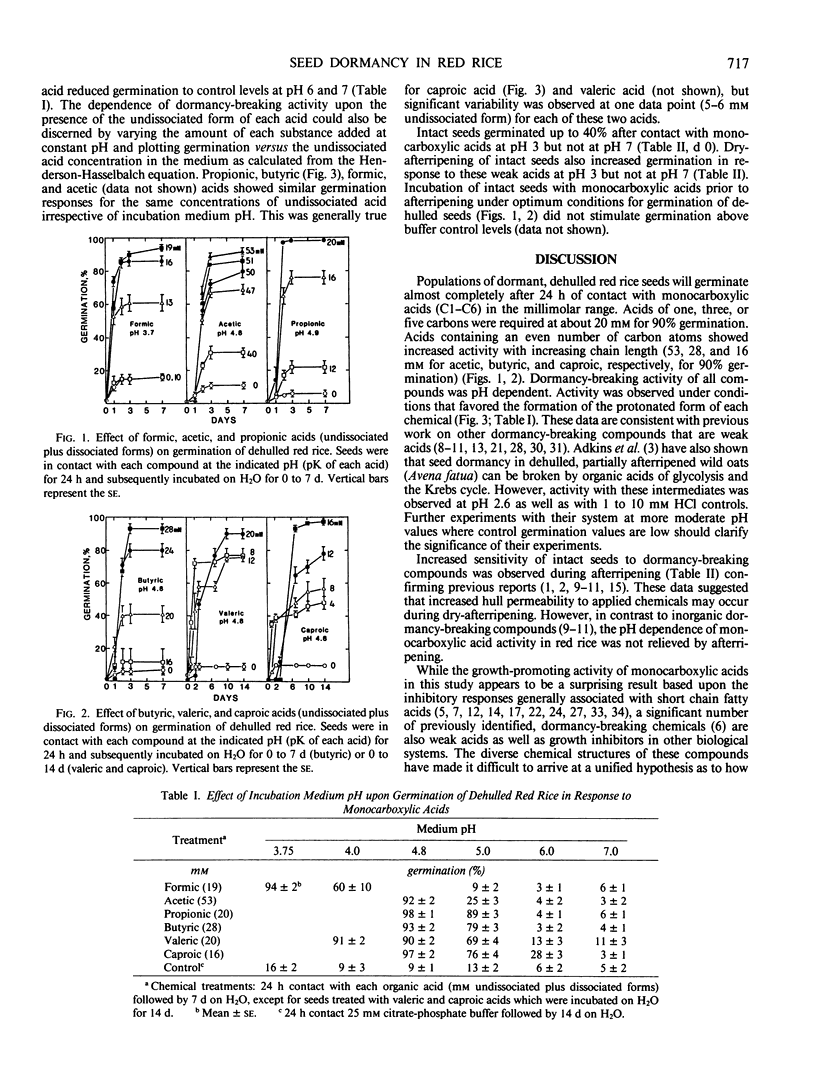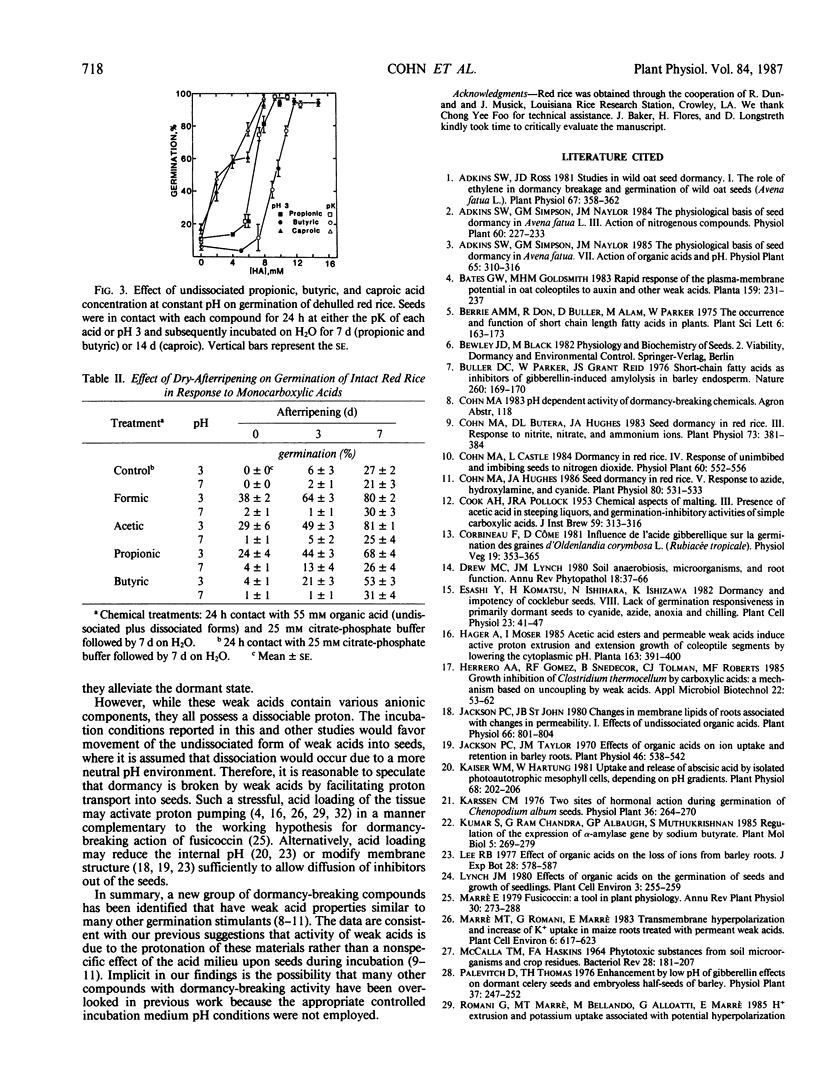Abstract
The weak acid character of many previously identified, but otherwise chemically dissimilar, dormancy-breaking compounds may contribute to their physiological activity. To test this idea, short chain monocarboxylic acids of one to six carbons, for which no previous reports of such activity exist, were incubated with dormant, dehulled red rice (Oryza sativa) seeds. Greater than 90% germination was observed after 24 hours of imbibition with 19 millimolar formic, 53 millimolar acetic, 20 millimolar propionic, 28 millimolar butyric, 20 millimolar valeric, or 16 millimolar caproic acid followed by 7 to 14 days incubation on water at 30°C. Dormancy-breaking activity was pH-dependent. Incubation medium pH values that favored formation of the protonated species resulted in the highest germination percentages. There was no promotive effect of medium pH itself in the range of 3 to 7. In contrast, germination of intact seeds was less than 40% in the presence of 55 millimolar monocarboxylic acids at pH 3, unless seeds were partially dry-afterripened. The pH-dependent activity of these acids was maintained during afterripening of intact seeds. The results are consistent with the idea that the dissociable proton of weak acids is responsible for their dormancy-breaking activity. Many other weak acids may break seed dormancy but have been over-looked due to the rigid pH dependence necessary for activity.
Full text
PDF



Selected References
These references are in PubMed. This may not be the complete list of references from this article.
- Adkins S. W., Ross J. D. Studies in Wild Oat Seed Dormancy: I. THE ROLE OF ETHYLENE IN DORMANCY BREAKAGE AND GERMINATION OF WILD OAT SEEDS (AVENA FATUA L.). Plant Physiol. 1981 Feb;67(2):358–362. doi: 10.1104/pp.67.2.358. [DOI] [PMC free article] [PubMed] [Google Scholar]
- Cohn M. A., Butera D. L., Hughes J. A. Seed Dormancy in Red Rice : III. Response to Nitrite, Nitrate, and Ammonium Ions. Plant Physiol. 1983 Oct;73(2):381–384. doi: 10.1104/pp.73.2.381. [DOI] [PMC free article] [PubMed] [Google Scholar]
- Cohn M. A., Hughes J. A. Seed dormancy in red rice : v. Response to azide, hydroxylamine, and cyanide. Plant Physiol. 1986 Feb;80(2):531–533. doi: 10.1104/pp.80.2.531. [DOI] [PMC free article] [PubMed] [Google Scholar]
- Jackson P. C. Changes in Membrane Lipids of Roots Associated with Changes in Permeability: I. EFFECTS OF UNDISSOCIATED ORGANIC ACIDS. Plant Physiol. 1980 Nov;66(5):801–804. doi: 10.1104/pp.66.5.801. [DOI] [PMC free article] [PubMed] [Google Scholar]
- Jackson P. C., Taylor J. M. Effects of organic acids on ion uptake and retention in barley roots. Plant Physiol. 1970 Oct;46(4):538–542. doi: 10.1104/pp.46.4.538. [DOI] [PMC free article] [PubMed] [Google Scholar]
- Kaiser W. M., Hartung W. Uptake and Release of Abscisic Acid by Isolated Photoautotrophic Mesophyll Cells, Depending on pH Gradients. Plant Physiol. 1981 Jul;68(1):202–206. doi: 10.1104/pp.68.1.202. [DOI] [PMC free article] [PubMed] [Google Scholar]
- MCCALLA T. M., HASKINS F. A. PHYTOTOXIC SUBSTANCES FROM SOIL MICROORGANISMS AND CROP RESIDUES. Bacteriol Rev. 1964 Jun;28:181–207. [PMC free article] [PubMed] [Google Scholar]
- Mickelson E. M., Petersons J. S., Flournoy N., Clift R. A., Thomas E. D. An estimate of the recombination frequency between the B locus and the D locus within the major histocompatibility complex. Tissue Antigens. 1976 Oct;8(4):247–252. [PubMed] [Google Scholar]
- Toole V. K., Cathey H. M. Responses to gibberellin of light-requiring seeds of lettuce & Lepidium virginicum. Plant Physiol. 1961 Sep;36(5):663–671. doi: 10.1104/pp.36.5.663. [DOI] [PMC free article] [PubMed] [Google Scholar]


